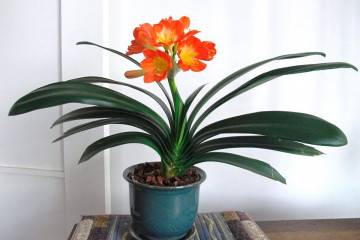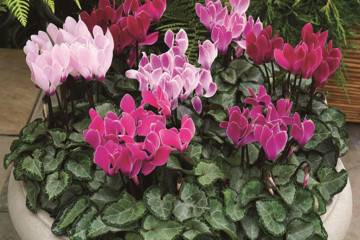Cyclamen - home care
Content:
In pursuit of beauty and decoration of their home, many buy ornamental plants. Most of them bloom actively in the warm season, and cyclamen differs in that the flowering period occurs in the cold season. Below are the features and rules for caring for a flower at home.
Cyclamen - what is this home flower
Cyclamen is a perennial flower, a herb from the Mirsinov family. There are more than 60 varieties in the genus, but only 20 of them are suitable for growing at home.
Characteristics and short description
It is a tuberous plant. The tubers have a flattened rounded shape, and their diameter increases depending on the age of the flower. Most often, the diameter varies from 5-6 cm, but in adult specimens it sometimes reaches 14 cm.On the surface you can see many buds, from which leaves and pedicels will grow in the future. Leaves are decorative heart-shaped. Growing from a dense root rosette, they have a bright rich green color and are decorated with silvery stains.
Flowers are located on dense and high legs, which rise significantly above the foliage. The length of the leg ranges from 12 cm for dwarf varieties to 30 cm. On a flowering plant, it can have up to 60 buds.
Varieties of indoor cyclamen
Every day, breeders are working on the development of new varieties and hybrids. The distinctive features of the most popular are described below.
Cyclamen persicum
This Persian perennial reaches a height of 30 cm. It has dark green leaves and bright pink inflorescences. This species is easier than the rest amenable to the process of reproduction through seeds. Flowering occurs in the autumn.
Cyclamen European, or blushing
This variety is characterized by the preservation of leaves even during the dormant period. Also, another distinctive feature is that the tuber is completely covered with roots, so it is completely covered with earth.
It has fewer inflorescences and leaves than other varieties. In addition, anthocyanin color can be seen on the back of the leaves, and the shades of the inflorescences vary from pink to purple. This variety blooms mainly in spring.
Cyclamen African
The inflorescences of this species have a pale pink color, and the leaves are much larger than those of congeners. They reach 15 cm in length and width. It is they who distinguish it among all types. Flowering occurs from spring to autumn.
Alpine cyclamen (Cyclamen alpinum)
A distinctive feature of the alpine cyclamen is the inclination of the inflorescences at an angle of 90 °, while in the rest it reaches 180 °.They are colored in various shades of pink and have a purple spot at the base. The flowers have a delicate pleasant aroma with hints of honey.
Cyclamen Colchis, or Pontic, and others
The appearance of leaves and flowers occurs simultaneously. The color is deep pink, and darkens closer to the edge. The length of the petals reaches 1.5 cm in length. Prefers shaded areas. The flowering period is from September to October.
Also known are varieties such as:
- Greek with unique white inflorescences. He was listed in the Red Book;
- kosky with deep pink flowers and green foliage of kidney shape;
- miniature Cypriot, which reaches a height of only 10-14 cm;
- ivy, etc.
How to care for cyclamen at home
Seeing a beautiful plant on the store shelf, many pass by, believing that caring for it will be difficult. Cyclamen, which is quite simple to care for at home, still belongs to demanding plants.
Illumination and temperature conditions
This flower loves well-lit rooms, while the light should be diffused. It is worth choosing the eastern or western sides.
The optimum temperature for growing cyclamen is considered to be 18-20 ° C. At the same time, the flower tolerates a drop in temperature much easier. Abundant flowering often occurs in winter, when the temperature in the room drops to 16-18 ° C. For a hot summer, when the temperature exceeds 25 ° C, it is recommended to lower the flower into a basement or a cool room and provide it with artificial lighting.
Watering rules and humidity
For watering, it is important to use settled soft water at room temperature. The flower does not tolerate excessive drying of the substrate, but at the same time, stagnation of water should not be allowed.
During the dormant period, the flower is sprayed from a spray bottle to maintain the required humidity, but as soon as buds begin to form, the procedure must be completed.
Top dressing and soil quality
The rate of development of the plant and the abundance of flowering depend on the quality of the soil. The soil should be loose and retain moisture well. The best option is a mixture of the following components:
- sheet soil;
- turf;
- crushed peat briquettes;
- river sand.
From the moment the first two leaves appear in the flower, it is necessary to make mineral and organic fertilizing a couple of times a month. During flowering, the procedure is suspended.
Flower container size
The activity of the growth and development of cyclamen depends on how correctly the pot is selected. Often for an adult plant, which is 3-4 years old, containers of 16-18 cm are suitable, for a young flower aged 1-2 years, they are optimal with a diameter of 8 cm.There should be a small free space between the walls and roots, 2-3 cm.
Pruning and replanting
Dry, yellowing and withering leaves must be cut off regularly. They do it at the very bottom. As the flowering is completed, the peduncle is removed. If you neglect this rule, then the flower will spend too much energy on wilting of the stems and will not receive the necessary rest for the rest period.
It is not recommended to disturb a flowering plant with a transplant. The procedure is carried out no more than 2 times a year. For transplanting, you will need a larger pot and new soil. The soil is preliminarily slightly moistened. All dead particles are removed from the tuber and carefully placed in a new pot. The voids are filled with soil, 1/3 should rise above the general ground level.
Features of flowering plants
The active phase of flower development requires special attention from the owner. Below is considered how cyclamen blooms, how to care for it during this period.
A period of activity and rest
Cyclamens are ephemeroids. This means that the period of flowering, fruiting and vigorous growth occurs during the cold season. The time may vary slightly depending on the frost resistance of the varieties.
Types and shape of flowers
Cyclamen flowers are relatively small. The main part of them deviates downward, and the petals themselves look up. Having blossomed, they resemble a flock of butterflies. The color scheme is varied: from snow-white to bright purple shades. They are bisexual, that is, each has a pistil and a stamen.
How to care for cyclamen after flowering
During the entire flowering period, cyclamen needs abundant soil moisture. But after its completion, the situation changes dramatically. Watering is significantly reduced, and as the foliage dries up and the tuber is exposed, it should be scarce and scarce.
Flower reproduction methods
Growing cyclamen at home, sooner or later the owner thinks about reproduction, which in the future can be presented to friends and family for a celebration. Knowing how cyclamen reproduces can help you achieve success faster.
Reproduction by dividing the tuber
This is a widely used method and is preferred by most growers due to its simplicity and effectiveness. However, it is important to consider that the tuber is a vulnerable part. Here it is important to follow some recommendations on how to propagate cyclamen correctly.
The procedure takes a total of 2-3 days:
- First, the soil is moistened. This is to facilitate the removal of the root system from the pot.
- After a day has passed, you can begin to divide. To do this, the soil is washed off the roots with the help of settled water at room temperature.
- With a sharp knife, carefully cut the tuber into 2 parts. The maximum permissible number of divisions from one onion does not exceed 4 pieces. The place of the incision should be in such a way that on each part there is at least one growth point and a heel from which the roots will grow.
- Leave the cut for 3-4 hours to dry, after which the cut sites are treated with charcoal powder and left for another 18 hours to dry.
As the division of the bush is completed, you can start planting in the ground.
Also, if, during a planned transplant, new formed small shoots were noticed on the maternal tuber, then they can be used as planting material. To do this, the baby is carefully separated from the main bush, the cut points are treated with crushed activated carbon and planted in a glass with ordinary soil. Cover the top with a film or other glass, creating a greenhouse effect. As the leaves germinate, the film is removed and the flower is looked after as if it were an adult.
Seed propagation
It is quite difficult to propagate cyclamen from seeds. For the entire period, you will have to be patient and persistent.
First, the seeds are soaked for 8 hours in a stimulating solution. In a container with the usual soil, small holes are made, which do not exceed 1 cm in depth. They are moistened and covered with seeds.
Darkness is of particular importance for successful germination, so it is recommended to use black film to create a greenhouse effect.
The first shoots will hatch for 30-40 days. With the appearance of seedlings, the shelter is removed and a comfortable temperature of 18-19 ° C is provided. As 2-3 true leaves appear, a pick is made, and the nodules are sprinkled with earth.After six months, a full-fledged plant can be transplanted into a separate pot, the tuber is placed in the soil only 2/3 so that the top is slightly above ground level.
Growing problems, diseases and pests
Like every home flower, cyclamen is susceptible to disease and pests.
The most dangerous for the plant are:
- elephant beetle whose larvae feed on tubers;
- scale insect that damages leaves;
- cyclamen mite that infects buds and leaves.
The affected areas are treated with soapy water or insecticides.
In order to avoid the formation of gray rot, it is necessary to monitor the watering of the plant. It should be regular, and after 2-3 hours the excess moisture is removed from the pallet. When transplanting, the dead roots are cut off, and the cut sites are treated with coal.
Each plant is beautiful in its own way. So that it does not die and pleases the eye of the owner, it is important to follow the rules. Caring for a cyclamen flower at home is exactly what it requires.





















